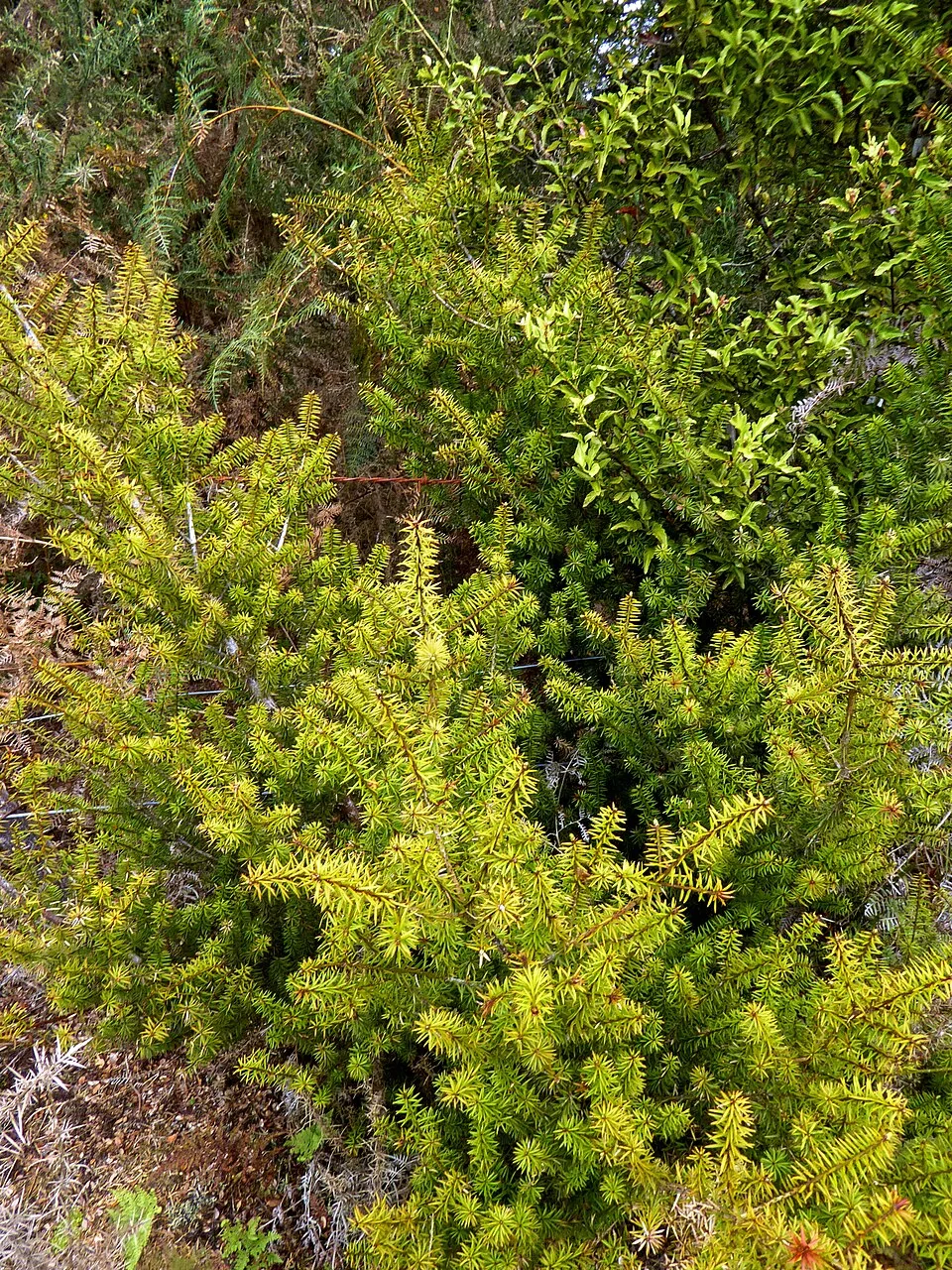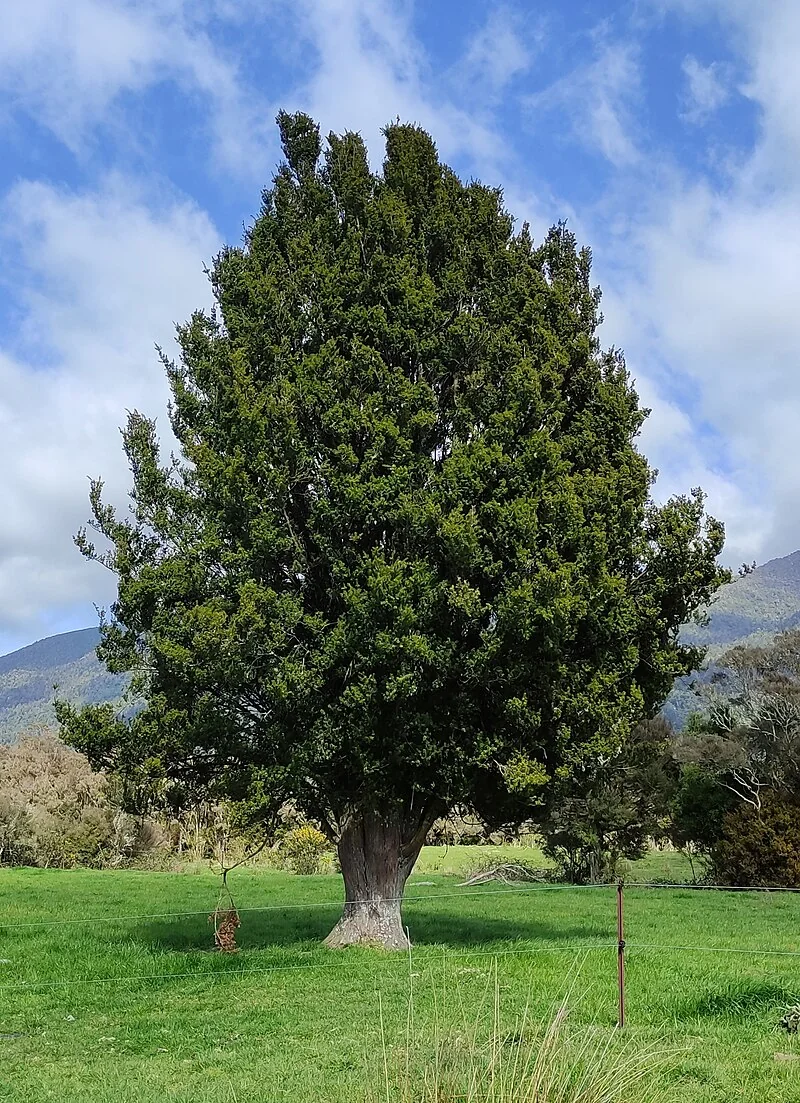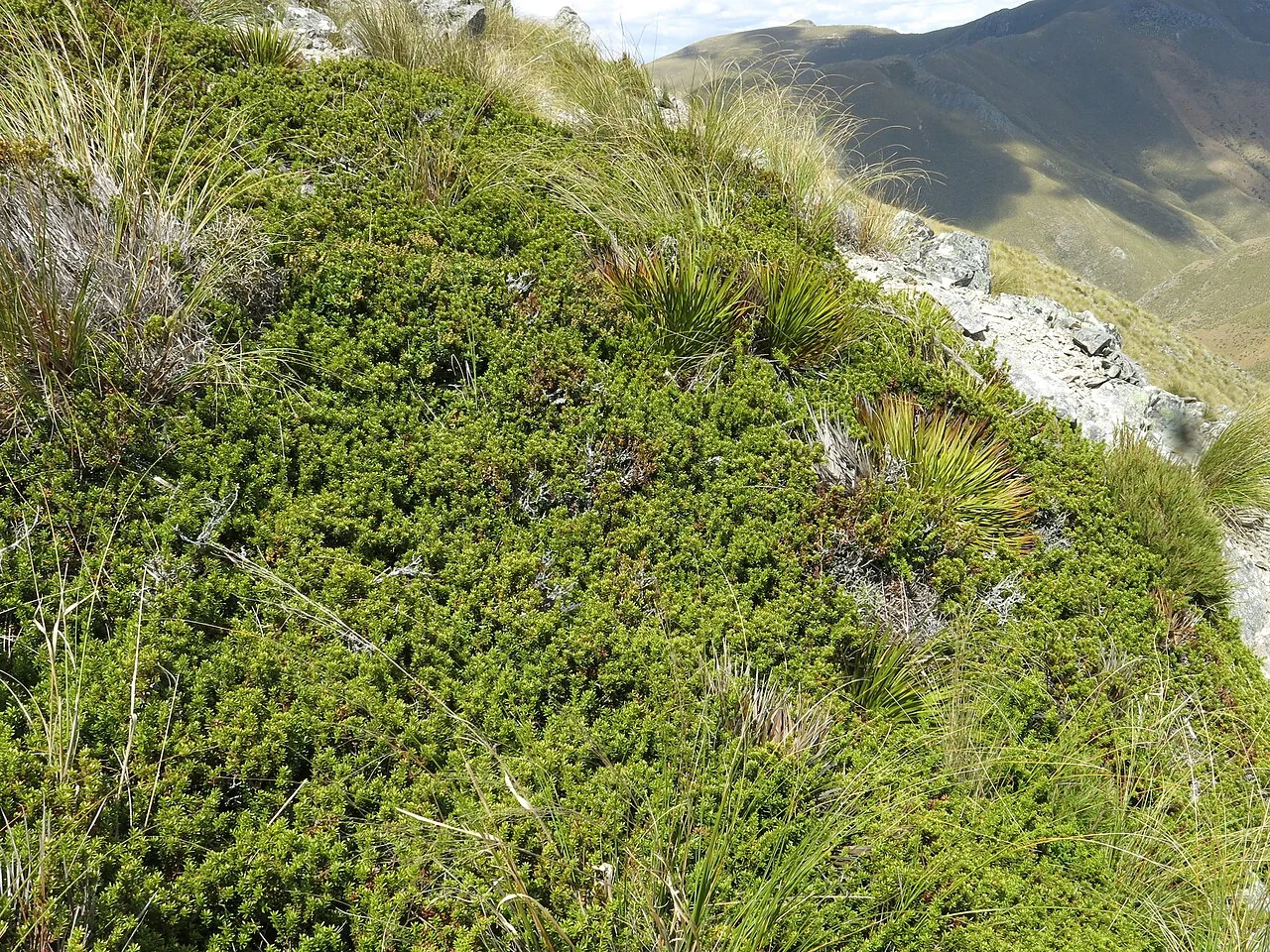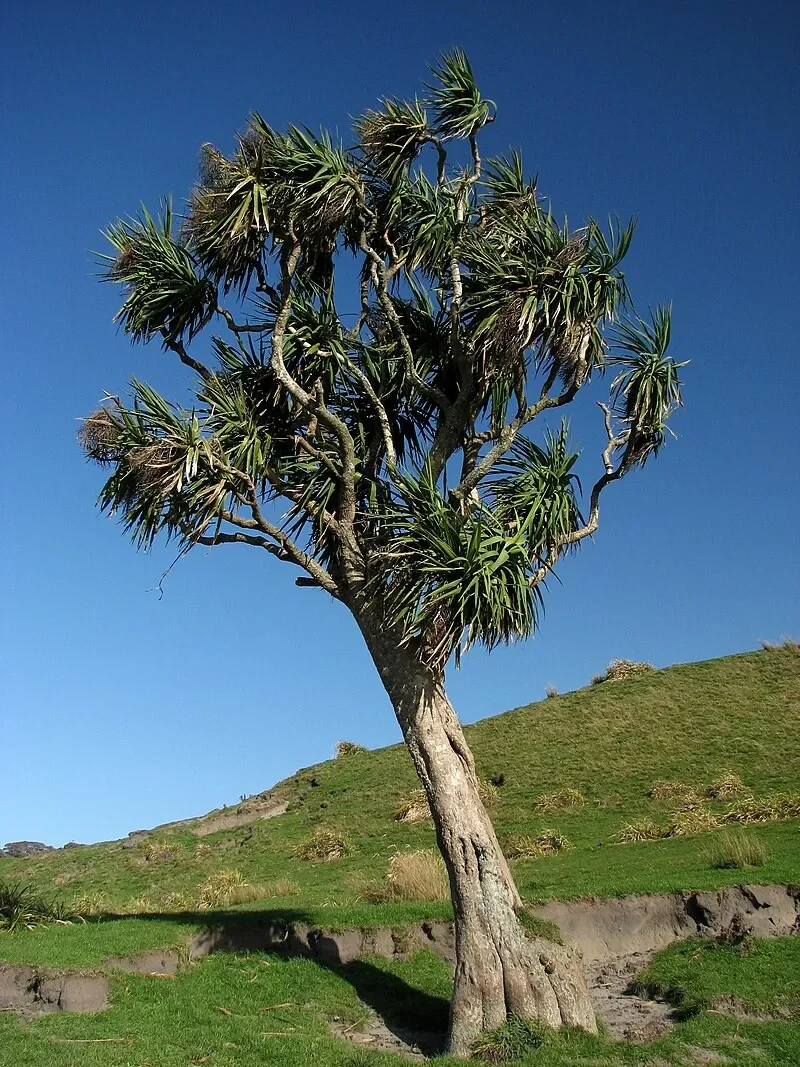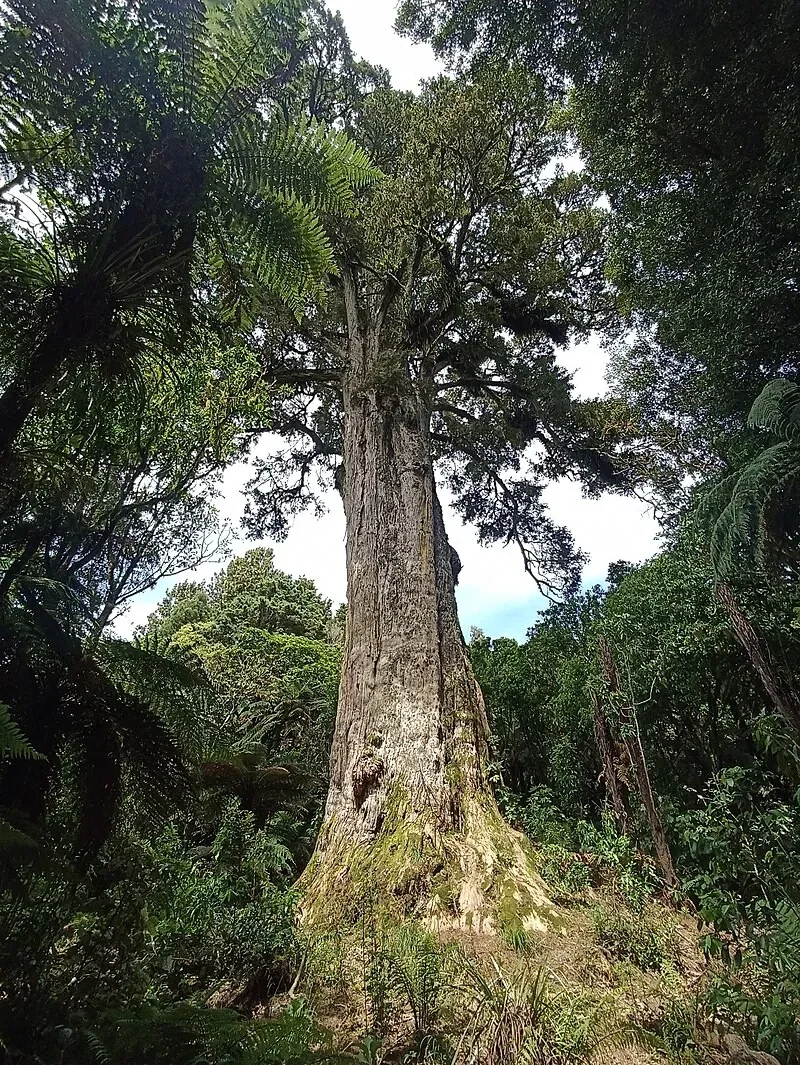
Tōtara
Podocarpus totara
Tōtara ( Podocarpus totara ) is a long-lived podocarp and one of Aotearoa's iconic timber trees. With flaky, reddish-brown bark and tough juvenile foliage, it matures into a tall canopy tree producing bird-dispersed seed. Widely used in restoration and as a shelter or specimen tree. Learn more in our native plants guide .

Plant Description
Botanical Features
Tōtara ( Podocarpus totara ) is a prominent species of podocarp tree native to New Zealand. It is a robust, slow-growing conifer that can reach impressive heights of up to 30-35 meters and develop a massive trunk with a diameter of 2-3 meters. The bark is thick, corky, and deeply furrowed, with a reddish-grey hue. It sheds in long, stringy strips. In its early stages, the tōtara is bushy, but older trees become more open. Its leaves are brownish to dark green, linear-lanceolate, stiff, leathery, and needle-like, typically 15-30 mm long and 3-4 mm wide in adult trees. They spiral along the branches. Tōtara is a dioecious conifer, meaning it has separate male and female trees. Male trees produce pollen cones, while female trees develop small, fleshy ovule cones. After fertilization, the bases of the fertile and sterile bracts fuse and become a fleshy, red, swollen, and sweet-tasting "fruit" (receptacle) that supports one or two seeds. These "fruits" are edible and are a food source for native birds, aiding in seed dispersal.
Quick Facts
Overview
| Scientific Name | Podocarpus Totara |
|---|---|
| Height | 20-30 m (occasionally higher) |
| Spread | 8-15 m |
| Light | Full sun to light shade |
| Water Needs | Moderate while establishing; low later |
| Frost | Good once established |
| Frost Tolerance | Hardy once established |
| Salt Tolerance | Low; requires protection from salt exposure |
| Growth Rate | Slow |
| Lifespan | Very long; can live for over 1000 years |
Climate Best Suited to
Regional climate suitability across major New Zealand cities.
Regional Suitability
| City | Climate Suitability |
|---|---|
| Whangārei | Ideal |
| Auckland | Ideal |
| Hamilton | Ideal |
| Tauranga | Ideal |
| Rotorua | Ideal |
| Gisborne | Ideal |
| New Plymouth | Ideal |
| Napier | Ideal |
| Whanganui | Ideal |
| Palmerston North | Ideal |
| Wellington | Ideal |
| Nelson | Ideal |
| Christchurch | Ideal |
| Dunedin | Ideal |
| Invercargill | Ideal |
Natural Habitat
Tōtara ( Podocarpus totara ) is a prominent species of podocarp tree endemic to New Zealand, found throughout both the North and South Islands, with the exception of Stewart Island where it is extremely scarce. It is a highly adaptable species, thriving in a variety of habitats.
Key Habitats Include:
- Lowland, Montane, and Lower Subalpine Forests: Tōtara is a significant component of these forest types, often acting as an emergent tree. It is widespread below the zone where Nothofagus (beech) begins to dominate.
- Elevations: It can be found at elevations up to 600 meters (2000 feet) in the North Island and 500 meters in the South Island.
- Alluvial Plains and Hill Slopes: It commonly grows on alluvial plains and hill slopes, indicating its preference for well-drained, fertile soils in lowland areas.
- Farmland and Pastoral Hill Country: Tōtara is remarkably resilient and is often found regenerating on farmland and in pastoral hill country, as it is not typically eaten by livestock. It can establish in open sites, including sparse weedy grass cover.
Preferred Conditions:
- Soil: Tōtara is more tolerant of dry soils and seasonal drought than other podocarps, but it is intolerant of poorly drained soils. It prefers well-drained and fertile soils.
The presence of Podocarpus totara in these diverse habitats underscores its ecological importance in contributing to the biodiversity and structural complexity of New Zealand's native forests, and its resilience in various landscapes.
Plant Conservation
Conservation
Podocarpus totara , commonly known as tōtara, is a species of podocarp tree endemic to New Zealand. It is widespread throughout the North and South Islands and is noted for its longevity, growing up to 30-35 meters tall. Despite historical land clearance and timber harvesting that reduced the size of podocarp forests, the tōtara's current conservation status is "Not Threatened" nationally. However, as a vegetation type, tōtara forests are nearly extinct in much of much of their former range. Threats to tōtara and other native New Zealand forests include: land clearance and timber harvesting, introduced pests (possums, deer, sheep), weeds, and fire. Native insects and diseases can also damage tōtara trees. Conservation efforts and cultural significance: Tōtara is culturally significant to Māori, who traditionally used its rot-resistant wood for constructing canoes (waka) and carvings. Remnants of old-growth tōtara forests in the central North Island are protected in conservation areas. Tōtara is widely used in restoration projects and as a shelter or specimen tree due to its adaptability and success in cultivation. It can tolerate a wide variety of sites and is relatively light-demanding, making it suitable for open areas. Tōtara regenerates naturally on farmland after clearance in many regions, often found along fencelines or in second-growth stands, with birds aiding seed dispersal. The species is moderately resistant to browsing by cattle, though less so by sheep, and is susceptible to possum browsing when new growth is flushing.
Growing Requirements
Soil
Well-drained, moderately fertile soils preferred; avoids prolonged waterlogging.
Light
Performs best in full sun with some shelter in early years.
Water
Keep moist while establishing; drought tolerant later.
Temperature
Hardy in most regions of New Zealand.
For Tōtara ( Podocarpus totara ), choose a site with full sun to light shade and soil that is well-drained, moisture-retentive. Incorporate composted organic matter to improve structure and drainage. Plant with the crown or root collar at soil level, then apply a 5-8 cm mulch to moderate temperature, conserve moisture, and suppress weeds. Protect young plants from extremes while establishing and consider the stated frost tolerance (seasonal) when siting near exposure or cold air drains.
Planting Guide
Best Planting Practices
Plant tōtara in full sun to light shade on free-draining soils. Set the root flare at grade, mulch widely, and water deeply through the first summers to drive roots down.
- Soil: Loams and stony soils preferred; avoid waterlogged sites.
- Spacing: 6-8 m for long-term specimens or shelter rows.
- Shelter: Stake in exposed sites until established.
Ecosystem Notes
- Longevity: Long-lived canopy storing significant carbon.
- Succession: Establishes in open sites, persists into mature forest.
- Associates: With rimu, mataū, and kānuka in mixed forest mosaics.
Uses and Significance
Landscape and Cultural
Historic timber species of great cultural importance; excellent for restoration, large gardens, and shelter plantings.
Propagate Tōtara from fresh, cleaned seed sown promptly, or by semi-hardwood cuttings taken from current season growth using a free-draining medium and gentle bottom heat. Germination can be slow; maintain even moisture and hygiene.
Landscaping Ideas
- Specimen tree: Tōtara is an iconic native tree, ideal for parks and large gardens where its impressive stature and longevity can be fully appreciated as a magnificent focal point.
- Shelter belts: Forms durable and effective windbreaks in well-drained paddocks and exposed areas, providing crucial protection for more sensitive plants and livestock.
- Restoration: Serves as a key anchor species in lowland reforestation projects, helping to establish new forest ecosystems and support biodiversity due to its adaptability and resilience.
Seasonal Care Calendar
Spring
- Plant new trees; mulch
Summer
- Deep watering in drought
Autumn
- Weed control; light tidy
Winter
- Plant bareroot stock; stake in windy sites
Pruning and Maintenance
Techniques and Timing
Minimal pruning required beyond formative work to maintain a single leader.
Prune Tōtara lightly to maintain structure; remove damaged shoots and avoid hard cuts on older wood.
How to Grow Tōtara
Growing Tōtara successfully requires understanding its status as New Zealand's most widely planted native conifer and its excellent adaptability to cultivation. This majestic, slow-growing tree has been extensively propagated in nurseries since the early 1900s, demonstrating remarkable success in transplantation and establishment across various sites. The species' tolerance for diverse soil conditions, from fertile lowlands to challenging exposed sites, makes it exceptionally versatile for restoration projects and cultural landscape preservation. Understanding both seed and cutting propagation techniques, along with proper site selection and long-term care, enables successful cultivation of this culturally significant and ecologically important native tree.
From Seed
Seed propagation provides reliable results with Tōtara, though patience is essential as germination can extend over extended periods. Fresh seed offers the best germination rates, while proper stratification treatment improves timing and uniformity of emergence. Understanding the tree's dioecious nature helps with seed collection planning.
- Collect ripe seeds from female trees between May and June when fruits have turned green and mature
- Gather seeds from the ground or leaf litter beneath mature female trees for best viability
- Clean seeds thoroughly, removing all pulp and debris to prevent fungal contamination
- Apply 4-6 weeks of cold stratification at 4°C to break dormancy and improve germination
- Sow fresh seeds in spring using well-draining seed-raising mix with good aeration
- Plant seeds at appropriate depth, covering lightly with fine seed-raising mix
- Maintain consistent moisture without waterlogging throughout the germination period
- Provide bright indirect light and temperatures between 15-20°C for optimal conditions
- Be patient as germination may take over a year, with emergence often in late spring and summer
- Expect to raise seedlings for up to 2 years in nursery conditions before transplanting
- Take advantage of the species' excellent transplanting success when moving established seedlings
From Hardwood Cuttings
Hardwood cutting propagation offers excellent success rates with Tōtara, even when taken from mature trees. This method requires patience due to extended rooting times but provides reliable results when proper techniques and environmental conditions are maintained.
- Take hardwood cuttings during the dormant season from healthy, disease-free parent trees
- Select current season's growth that has fully matured and hardened off
- Cut 15-20cm long sections using sharp, sterilized cutting tools
- Make clean cuts just below nodes, ensuring each cutting has several potential rooting points
- Remove lower foliage while retaining needles on the upper portion of cuttings
- Apply hormone rooting compound containing IBA at high concentration for woody conifers
- Plant in well-drained potting mix with excellent aeration and drainage properties
- Provide bottom heat at 18-22°C to encourage root development
- Maintain high humidity while ensuring adequate air circulation to prevent fungal issues
- Be patient as rooting can take several months, requiring consistent care throughout
- Monitor for root development by checking for resistance when gently tugged
- Gradually acclimatize rooted cuttings to normal growing conditions over extended periods
From Semi-Ripe Cuttings
Semi-ripe cuttings provide an alternative propagation method, particularly effective when taken from upright leading shoots. This technique works well during the active growing season when growth hormones are most active.
- Select semi-ripe cuttings from upright, leading shoots during late summer
- Choose vigorous, healthy shoots from juvenile portions of trees when possible
- Take cuttings 10-15cm long from current season's growth that has begun to firm
- Remove lower needles while retaining foliage on the upper half of cuttings
- Dip cutting bases in appropriate rooting hormone for coniferous species
- Plant in sterile, well-draining propagation medium with excellent aeration
- Utilize mist propagation systems for optimal humidity control and success rates
- Maintain consistent temperatures and protect from direct sunlight
- Monitor closely for fungal issues and maintain proper sanitation practices
- Expect rooting to occur more quickly than hardwood cuttings but still require patience
Site Selection and Establishment
Tōtara adapts remarkably well to various site conditions, though optimal placement ensures best growth and long-term success. Understanding soil preferences and environmental tolerances helps maximize establishment success and future performance.
- Choose sites with fertile, moist but well-drained, humus-rich soil for optimal growth
- Ensure good drainage while maintaining consistent moisture during establishment
- Select sunny, sheltered positions when possible, though the tree tolerates partial shade
- Consider the tree's tolerance for exposed sites when planning shelter belt applications
- Plan for the tree's eventual large size, allowing adequate space for mature growth
- Plant during cooler months to reduce transplant stress and improve establishment
- Take advantage of the species' excellent transplanting success rate from nursery stock
- Consider both container-grown and bare-root planting options based on site requirements
Long-Term Care and Cultural Significance
Established Tōtara trees require minimal maintenance while providing immense cultural, ecological, and landscape value. Understanding proper care practices ensures healthy, long-lived specimens that contribute to New Zealand's natural heritage and ecosystem functions.
- Water regularly during the first two growing seasons, then adjust to local rainfall patterns
- Apply slow-release organic nutrition in spring, avoiding over-fertilization that promotes weak growth
- Maintain weed-free root zones and renew organic mulch annually around young trees
- Prune minimally, removing only dead, damaged, or crossing material as needed
- Avoid severe heading cuts that stress the plant and compromise natural form
- Appreciate the tree's slow growth while recognizing its exceptional longevity potential
- Understand the tree's cultural significance in Māori tradition and New Zealand heritage
- Support conservation efforts by growing this species as part of restoration projects
- Recognize the tree's role as a dominant species in native forest ecosystems
- Value the species' contribution to wildlife habitat and ecosystem diversity
Pests and Diseases
Common Problems and Solutions
- Root disorders: Waterlogging causes decline; ensure drainage.
- Scale/sooty mould: Manage with oils; improve airflow.
- Wind damage: Prune storm tears cleanly; avoid topping.
Cultural Significance
Cultural Importance
Tōtara and Craft
Tōtara is among the most culturally significant trees in Aotearoa: prized for carving, waka, house timbers, and fencing, with durable heartwood central to traditional and historic building.
Podocarpus totara , commonly known as tōtara, holds significant cultural importance, particularly for the Māori people of New Zealand. It is revered as a "rākau rangatira" or "chiefly tree" due to its impressive size, longevity (living over 1000 years), and valuable properties. Tōtara symbolizes strength and mana (prestige or authority) within Māori culture. The phrase "Kua hinga te tōtara i te wao nui a Tāne" ("A mighty tōtara has fallen in the forest of Tāne") is used to show respect upon the death of a prominent figure. It is also associated with Tūmatauenga, the god of war, and can be referred to as Tū-kau-Moana, or Tū who swims in the ocean, due to its use in waka (canoes). The wood of the tōtara is highly prized for its durability, straight grain, and resistance to rot, especially its heartwood. It was the primary wood used by Māori for carving, and tōtara carvings often adorn the front of marae (Māori meeting grounds). It was also the preferred material for constructing waka (canoes), including large war canoes capable of carrying 100 warriors, due to its relatively light weight and natural oils that prevent rotting. Beyond canoes, tōtara was used for houses, tools, weapons, musical instruments, toys, and storage containers. Both Māori and early European settlers used tōtara for medicinal purposes. The wood was burned to produce smoke for treating hemorrhoids and venereal diseases. Infusions of the bitter leaves were used for upset stomachs, and boiled inner bark provided a sweet liquid for fevers. The fleshy red berries of the tōtara are edible, and Māori men would collect them in baskets. The name "tōtara" itself is thought to refer to its spiky leaves, as "tara" in Māori means spike or thorn. The tree's resilience and adaptability to various conditions further contribute to its esteemed status.
Bonus Tip
Expert Growing Advice
For optimal long-term health, tōtara thrives with minimal pruning, focusing on formative work in its early years to establish a strong central leader. It deeply appreciates a cool, undisturbed root run and a dry crown, making mulching around the base beneficial while ensuring good air circulation.
